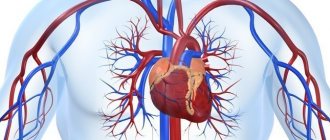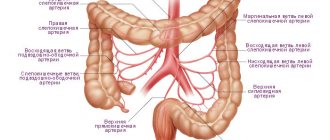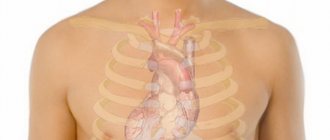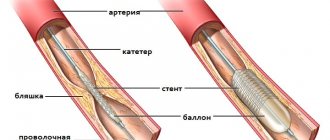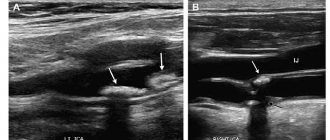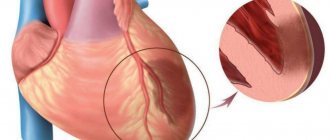An abrupt cessation of blood flow to any organ in the human body causes an acute condition such as a heart attack. This pathology can occur not only in the heart, but also in other organs. For example, blockage of blood clots in the lumen of an intestinal blood vessel leads to necrosis of the area of the intestine to which blood access was blocked. An atherosclerotic plaque may also be the cause.
Intestinal infarction is an acute surgical disease that can be fatal. Most often, this disease occurs in older people with a history of atherosclerosis, atrial fibrillation, and infective endocarditis. Cases of intestinal infarction have also been reported in young women taking combined oral contraceptives.
general description
Intestinal infarction is an acute surgical disease, which is based on the cessation of the flow (or outflow) of blood to the intestine.
Intestinal infarction is a serious disease in which death is not uncommon. The main cause of intestinal infarction is blockage of the lumen of a blood vessel by a thrombus or atherosclerotic plaque.
Intestinal infarction, as a rule, occurs in older patients with severe heart pathology (atrial fibrillation, infective endocarditis, atherosclerosis). It is extremely rare that intestinal infarction may occur in young women taking combined oral contraceptives.
Myocardial infarction (heart attack) - symptoms and treatment
A patient with an acute heart attack must be promptly transported to the hospital to prevent complications and increase the chances of survival. The system of care for patients with myocardial infarction includes the following stages:
- Pre-hospital stage. Ambulance teams provide assistance and transport the patient to the hospital.
- Hospital stage. Help is provided in specialized vascular departments.
- Rehabilitation stage. Rehabilitation is carried out in special departments of hospitals or specialized cardiological sanatoriums.
- Dispensary observation and outpatient treatment. Clinical examination in the post-infarction period is carried out in regional or city cardiology centers or in cardiology offices of clinics [6].
At the prehospital stage, the following tasks are solved:
- an accurate diagnosis is established. If this fails, it is permissible to establish a tentative syndromic diagnosis as soon as possible;
- The patient is given a nitroglycerin tablet under the tongue (or use a nitro-containing spray) and 0.25-0.35 g of aspirin;
- pain is relieved by administering painkillers;
- acute circulatory failure and heart rhythm disturbances are eliminated;
- the patient is brought out of the state of cardiogenic shock;
- in case of clinical death, resuscitation measures are performed;
- transport the patient to the hospital as soon as possible.
Further therapy is determined by the stage (period) of myocardial infarction. In the acute and very acute period, the goal of treatment is to prevent an increase in the focus of myocardial necrosis, eliminate pain and other symptoms. It is important to restore blood flow through the heart arteries and relieve pain. The intensity of pain during this period is so great that the patient may die due to cardiac arrest. It is necessary to prevent severe complications. When the disease passes into the subacute stage and in the post-infarction period, the goal of therapy is to reduce the risk of attack recurrence and possible complications.
For the treatment of acute myocardial infarction, drugs from various pharmacological groups are used:
Painkillers. Analgesics from the group of narcotic painkillers (morphine, promedol, omnopon) in combination with analgin, antihistamines (diphenhydramine). Neuroleptanalgesia is most effective when a combination of the analgesic fentanyl with the strong antipsychotic droperidol is used. The effectiveness of these drugs is noticeable within a few minutes. Not only pain disappears, but also fear of death, unmotivated anxiety and psychomotor agitation. Tranquilizers (diazepam) can be used to relieve psychomotor agitation. To reduce hypoxia (decreased oxygen in tissues), oxygen inhalation is used using a nasal catheter.
Thrombolytic therapy. It is important to restore blood flow and dissolve blood clots so that the death of the heart muscle does not spread further. The smaller the area of necrosis, the higher the patient’s chances of successful rehabilitation and the lower the risk of life-threatening complications. Immediate use of drugs (preferably within the first hour after an attack) allows you to achieve maximum effectiveness of treatment. A time limit of three hours is allowed. To dissolve a blood clot, thrombolytic drugs are administered intravenously, for example, streptokinase, urokinase, alteplase. The dose depends on the patient's weight.
Restoration of coronary blood flow is also possible with the help of surgical treatment - stenting or coronary artery bypass grafting. A balloon catheter is inserted into a narrow section of the artery under fluoroscopic guidance. In this case, the atherosclerotic plaque is “crushed”, and the lumen of the heart artery increases. Then a stent (metal frame) can be installed into the lumen of the vessel.
Antiplatelet agents. Drugs from this group affect blood cells (platelets and red blood cells). The action of antiplatelet agents prevents platelet aggregation, improving blood flow. The main drug used is aspirin (acetylsalicylic acid). Contraindications to the use of aspirin: bleeding from the gastrointestinal tract, exacerbation of gastric or duodenal ulcers.
P2Y12 platelet receptor inhibitors are also used , which block platelet activation. The main blockers are ticagrelor, prasugrel and clopidogrel.
Intravenous/subcutaneous anticoagulants. , unfractionated heparin intravenously, is used to prevent deep vein thrombosis (DVT) and pulmonary embolism (PE) . Enoxaparin , which is also used to prevent venous thromboembolism, is administered subcutaneously.
To limit the area of myocardial ischemia and necrosis, it is necessary, in addition to restoring blood flow in the arteries of the heart, to reduce the hemodynamic load on the heart. Nitrates and beta blockers are used for this purpose.
Nitrates. They have an analgesic effect, reduce myocardial oxygen demand, increase coronary and collateral (bypass) blood flow, reduce the load on the heart muscle, and limit the size of the myocardial lesion. Their combination with beta blockers is especially effective, leading to rapid positive ECG dynamics and reducing the risk of sudden death [10].
Beta-blockers have an antiarrhythmic effect. The purpose of using beta-blockers (propranolol, metoprolol, atenolol) is to reduce the frequency and force of heart contractions, which will help reduce the load on the heart and the myocardial oxygen demand. Beta blockers continue to be used indefinitely in the absence of side effects and contraindications [1].
Diagnostics
Important factors for establishing the correct diagnosis are advanced age, the presence of severe atherosclerosis, especially atherosclerosis of the abdominal aorta and lower extremities, and thromboembolic processes.
Instrumental diagnostic methods:
- X-ray examination - survey radiography of the abdominal organs.
- Laparoscopy.
- Aortography.
- Selective mesentericography, which allows you to diagnose any type of circulatory disorders at the earliest possible time.
Why does intestinal infarction occur?
“In children, for example, the disease is uncommon, but most often it develops against the background of intestinal volvulus. Volvulus can occur if we are faced with adhesive intestinal obstruction, when connective tissue cords form in the abdominal cavity, which stretch from the anterior abdominal wall to the intestinal loop, and around the so-called. the intestinal loop may become twisted, and a circulatory disorder in its wall may occur,” says Alexey Stepanov.
Another possibility is volvulus as a result of incomplete rotation of the intestine, the surgeon says. “This is a congenital disease, when any period of intestinal rotation is disrupted, it is disrupted in utero, and the child is born with such a pathology when the entire small intestine is located in the right parts of the abdominal cavity, and the large intestine is folded in the form of a double-barreled gun and is located in the left half. The main thing is that the small intestine and part of the large intestine have a common mesentery. This is a film through which the vessels supplying the intestines pass,” notes Alexey Stepanov.
To break. Why does intestinal injury occur and what can be done about it? More details
Often, the surgeon says, when volvulus occurs, the entire small intestine wraps up, circulatory disturbances occur in its wall with the development of intestinal infarction and necrosis of very large areas of the intestine, sometimes of the entire small intestine. “Therefore, if a disease such as incomplete intestinal volvulus is detected, or if there is an appropriate clinic, it is necessary to perform an operation as soon as possible to restore the normal anatomical relationships of the abdominal organs, or be always on guard, because such a serious disease as intestinal volvulus can happen Anytime. The combination of incomplete rotation with volvulus is called Ladd syndrome,” notes the surgeon. If such a disease is detected, it is necessary to contact a surgeon as soon as possible, the specialist emphasizes.
Article on the topic
How gut health affects COVID-19 Another cause of intestinal infarction is mesenteric thrombosis, which is most common in adults. This is very rare in children, but not impossible. It happens that it develops against the background of some kind of vascular pathology, most often of the arteries, for example, as a result of endarteritis there can be distant thrombosis, but not only of the mesenteric vessels, but also of other main vessels, including the vessels of the mesentery. If thrombosis of the mesentery occurs, then the so-called. mesenteric thrombosis with the development of intestinal infarction.
“In this case, a fairly characteristic clinical picture develops, which manifests itself in the form of severe abdominal pain, nausea and vomiting, a general serious condition, severe intoxication, and dry skin. Sometimes streaks of blood first appear in the stool, sometimes intense intestinal bleeding occurs,” the specialist notes. If such symptoms appear, especially if it is already known that the patient suffers from endarteritis, says Alexey Stepanov, you must first rule out mesenteric thrombosis and also consult a surgeon in a timely manner.
Incidence (per 100,000 people)
| Men | Women | |||||||||||||
| Age, years | 0-1 | 1-3 | 3-14 | 14-25 | 25-40 | 40-60 | 60 + | 0-1 | 1-3 | 3-14 | 14-25 | 25-40 | 40-60 | 60 + |
| Number of sick people | 0 | 0 | 0 | 4 | 6 | 7.8 | 8.7 | 0 | 0 | 0 | 4 | 6 | 7.8 | 8.7 |
What causes a large number of deaths from intestinal infarction?
The high percentage of mortality that develops against the background of intestinal necrosis occurs is explained by the rapid spread of the intestine. In a short time, irreversible changes that disrupt blood flow lead to a complete lack of functional activity of the intestine. In addition, due to diagnostic difficulties, help is provided late in most cases.
Manifestations of intestinal necrosis
The development of symptoms characteristic of intestinal necrosis occurs with pronounced changes in the tissues. The period can last up to six hours. The main specific manifestation characteristic of the disease is the Kadyan-Mondor symptom.
Diagnostic stages
1. Consultation with a gastroenterologist
After a detailed study of complaints and anamnesis of the disease and life, a thorough medical examination, the gastroenterologist develops an examination plan individual for each patient. A gastroenterologist may prescribe consultations with other specialists, for example, an infectious disease specialist or a psychotherapist.
2. Endoscopic examination (gastroscopy)
The gold standard and a necessary stage of modern examination, even in the case of presumably neurogenic pain. Modern techniques used at the Yauza Clinical Hospital, including combined (endo-ultrasound), significantly expand the diagnostic capabilities of conventional fibrogastroscopy.
3. Laboratory diagnostics
Depending on the direction of the diagnostic search and the results of endoscopy, laboratory tests (blood, urine, feces, gastric juice, testing for Helicobacter, etc.) are prescribed.
At the Yauza Clinical Hospital, it is possible not only to conduct a thorough examination of the gastrointestinal tract (ultrasound and endoscopy, radiation diagnostics - CT and MRI, laboratory diagnostics) but also basic related pathologies, for example, examination of the cardiovascular system or cancer search.
Stages of the disease
In its development, mesenteric infarction goes through three successive stages.
- Ischemic – circulatory disorders are reversible. Symptoms are nonspecific, which complicates diagnosis.
- Necrotic - cells of the intestinal wall die from oxygen starvation resulting from ischemia.
- Stage of peritonitis - the intestinal wall is destroyed, intestinal contents enter the abdominal cavity, and acute infectious inflammation of the peritoneum develops.
Treatment
When low-intensity pain in the stomach occurs for the first time, it is necessary to adjust the diet and diet: give up spicy, fried and fatty foods, limit the size of portions, reconsider the time of dinner. It is possible to take sorbents and a single dose of analgesics.
If stomach pain does not go away within an hour or two, this is a reason to consult a doctor and even seek emergency help.
Treatment of stomach pain depends entirely on the results of the examination. Depending on the identified cause of pain, different methods can be used - conservative (diet, drug treatment) and surgical methods (including endoscopic, laparoscopic).
If you are worried about stomach pain, contact the Clinical Hospital on Yauza. In our hospital, comprehensive diagnostics can be carried out using expert-level equipment; our doctors will quickly and effectively eliminate the causes of pain and relieve you of the unpleasant symptom.
You can see prices for services


